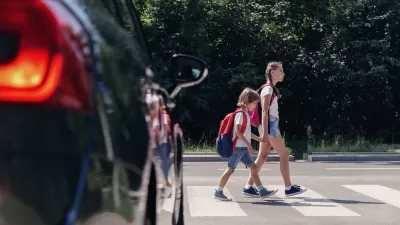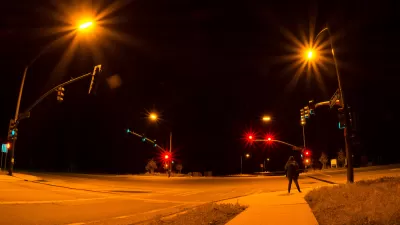The federal manual governing road design is getting an update. Will it encourage real progress toward road safety?

A post on the National Association of City Transportation Officials (NACTO) website outlines the key reforms the organization is looking for in the newly revised Manual on Uniform Traffic Control Devices (MUTCD), the federal document that dictates how roads are built in the United States.
For many safe streets advocates, the MUTCD is uniquely responsible for the unsafe design of many American roads, where over 40,000 people lose their lives each year. As NACTO points out, “The MUTCD governs all road markings, stop signs, and traffic lights in the U.S., and prioritizes moving vehicles quickly at the expense of safety, sustainability, and accessibility for people walking, biking, using a wheelchair, or riding transit.”
Some of the changes NACTO hopes for in the new MUTCD, which will be released after a review by the Office of Management and Budget (OMB), include:
- Elevating safety and implementing a ‘safe systems’ approach
- Eliminating the 85th percentile rule and other free-flow speeds in setting speed limits.
- Reforming regulations for signals to make street crossings safer for pedestrians.
- Removing the manual’s new proposed chapter on autonomous vehicles, which, according to NACTO, “absolves AV companies of the responsibility to build vehicles that keep road users safe within the existing transportation network.”
- Removing unnecessary restrictions on the use of paint for bus lanes, bike lanes, and crosswalks; and eliminating design restrictions for urban bikeways that conflict with data on bike safety.
FULL STORY: It’s Time to Reshape the Federal Document That Shapes Our Streets: The MUTCD

Alabama: Trump Terminates Settlements for Black Communities Harmed By Raw Sewage
Trump deemed the landmark civil rights agreement “illegal DEI and environmental justice policy.”

Planetizen Federal Action Tracker
A weekly monitor of how Trump’s orders and actions are impacting planners and planning in America.

Why Should We Subsidize Public Transportation?
Many public transit agencies face financial stress due to rising costs, declining fare revenue, and declining subsidies. Transit advocates must provide a strong business case for increasing public transit funding.

Phoenix Announces Opening Date for Light Rail Extension
The South Central extension will connect South Phoenix to downtown and other major hubs starting on June 7.

How Housing as a Financial Product Harms Communities
Institutional buyers who treat housing as an investment product become disconnected from the impacts of higher rents, displacement, and housing instability.

Blinded by the Light: When Brighter Headlights Decrease Safety
Bright LED headlights can create glare and reduce visibility for other drivers and pedestrians.
Urban Design for Planners 1: Software Tools
This six-course series explores essential urban design concepts using open source software and equips planners with the tools they need to participate fully in the urban design process.
Planning for Universal Design
Learn the tools for implementing Universal Design in planning regulations.
Caltrans
Smith Gee Studio
Institute for Housing and Urban Development Studies (IHS)
City of Grandview
Harvard GSD Executive Education
Toledo-Lucas County Plan Commissions
Salt Lake City
NYU Wagner Graduate School of Public Service





























